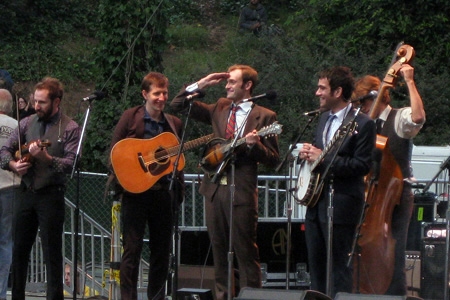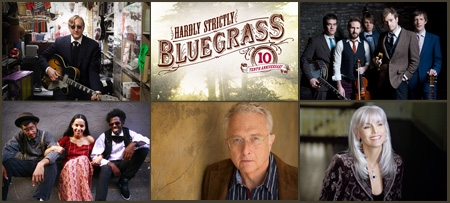These songs originated in a 1996 re-staging of Sam Shepard's Tooth of Crime and evolved over a decade into this dark, atmospheric disc, which Variety calls "as smart and distinct as his production on top-shelf albums." Among Burnett's co-conspirators are singer Sam Phillips, guitarist Marc Ribot, multi-instrumentalist Jon Brion, and Shepard himself.
"as smart and distinct as his production on top-shelf albums" —Variety
Tooth of Crime—completed fresh off Burnett’s acclaimed work as producer and arranger of the hugely successful Robert Plant / Allison Krauss collaboration, Raising Sand—is an outgrowth of a long-running collaboration with playwright Sam Shepard that began with the 1996 musical staging of his noted play Tooth of Crime (Second Dance) in New York. The songs are distillations of modern conflicts and personal drama in a modern hyper-reality. Following Burnett’s highly praised 2006 album The True False Identity—itself a dynamic return to action after a 14-year hiatus as a recording artist—this new collection is the realization of years of work to fully capture the inspiration of Shepard’s forceful ideas.
“Tooth of Crime is a prophetic play that Sam first wrote in 1972, and it takes place in a time very much like now,” Burnett explains. “It’s a time when there are zones of fame that flare up and people can become incredibly famous in their own zones and nobody outside that zone can know anything about it. When the zone completely disappears, the famous person doesn’t realize it, the only way to even find the zone being to hook up a toaster to a television to a microwave to a piano, then possibly you can tune it in. That was the initial inspiration for the album.” Tooth of Crime is not a cast album from the play—which isn’t a musical, but rather a theater piece in which characters sing. The album’s song cycle is a distinct entity.
“I recorded several of things for the play,” he says. “Then the play kept changing. Only six or seven of the tunes ended up in the play and it didn’t seem like an album. But I kept going back and working on things and seeing what I could do. Then I found a couple of pieces, things that had come up during the production but hadn’t ended up in the play, that I had forgotten we’d recorded, and I was able to finish a couple of those tunes. Of course, I was doing a lot of other projects, so it ended up being a long process to just getting a handle on what this album was going to be.”
Ultimately he was able to use the innate strengths of Tooth of Crime to form the foundation of an album that is a complete work unto itself. “These days one of the hardest things to do is find a frame at all to make the songs hang together,” he says. “It’s a great advantage working in this context with an incredible and soulful artist like Sam Shepard.”
Working with what has become a solid musical team anchored by Marc Ribot (Tom Waits, Elvis Costello, John Zorn) and drummer Jim Keltner (John Lennon, George Harrison, Eric Clapton, et al.), Burnett crafted the sound of Tooth of Crime into a unique aesthetic. It’s an approach that has evolved over decades of distinctive work for Burnett, both as a recording artist in his own right and in guiding an elite roster of artists and movie music projects: The 2000 Grammy Album of the Year O Brother, Where Art Thou? soundtrack; the Oscar-nominated “The Scarlet Tide” for the film Cold Mountain (for which he also produced the soundtrack); albums by Bob Dylan, Elvis Costello, Los Lobos, Roy Orbison, Ralph Stanley, Tony Bennett, and k.d. lang; and recent projects such as Raising Sand, the re-imagining of the Beatles catalogue in Across the Universe, and the music for the Johnny Cash biopic Walk The Line, are just highlights of a resume that stands as one of the most productive, distinctive, and lauded production careers of modern music.
“We’ve got a custom shop over here and we sort of do what they do on Monster Garage but with sound,” he says of his recording studio. “‘Let’s turn this pickup truck into a golf cart or something.’ We’ve been experimenting with it for ten years, the same team of people. It’s gotten more and more interesting as everybody brings more and more to the party each time.”
“These days one of the hardest things to do is find a frame to make the songs hang together,” he says. “It’s a great advantage working in this context with an incredible and soulful artist and intellect like Sam Shepard.
The first track, “Anything I Say,” is an enticingly jarring entry point, the lyrics and music combining to paint a vivid picture with via some unconventional approaches. Keltner’s inventive drum playing paves the path for an offbeat amble of a rich horn chart by Darrell Leonard (heavy on the lower registers with euphonium and other “deep brass”), Burnett’s six-string bass, and Ribot’s twisted guitar approach. “I’m not even sure you’d recognize it as guitar,” Burnett says. “It’s more percussion.”
Next comes the duet with Phillips on “Dope Island.” “It’s a disturbing place,” he says. “For one thing, people talk about the apocalypse as something that’s coming. But I think it’s something we’re living in and that’s what this play and album were imagining. But not now, the future—but not in the future.” Ribot and Leonard again make sterling contributions, with Los Angeles veteran Greg Leisz adding steel guitar.
“The Slowdown” wasn’t used on stage, but was written to be a “cheerful ditty” for a point “where the hero begins to be perplexed by the events that are beginning to overtake him and his team is trying to brace him.” Phillips and singer-songwriter David Poe join Burnett on the vocals. Blind Man” again spotlights Phillips on a song co-written by Burnett and Poe that also didn’t make the stage production.
“Kill Zone” has a soaring melody inspired by Roy Orbison, who in fact co-wrote it—shortly before his death—with Burnett and Bob Neuwirth. “It’s all very romantic, though comedic and tragic,” Burnett says. “That’s one of the things I learned working with Shepard—something will happen on stage and the person on your left will laugh and the person on your right will gasp in horror.” Musical wizard Jon Brion guests on baritone guitar, complementing Keltner, Leisz, and Leonard’s sonic painting.
“I just tried to get as murderous as possible,” is how Burnett describes “The Rat Age,” the song written to start the play’s second act. “I wrote this one by myself, a particularly evil little turn. And Ribot can always provide some serious threat. His guitar part has real threat in it, pretty broken down.” “Swizzle Stick” ratchets up the macho to an exaggerated level Burnett calls comedic in the tradition of such R&B classics as Willie Mabon’s 1954 hit “Poison Ivy,” with percussion and horns combining into a relentless cadence.
“Telepresence” takes the sonic experimentation to its own extreme, leading to the climactic “Here Come the Philistines,” with its almost wistful evocation of a passed world of gangsters: “I Wish the good ol’ Cosa Nostra would make a come back. They were such a nice group compared to these thugs we have to live with now.”
And then it ends on a surprisingly gentle note with “Sweet Lullaby,” a peaceful if not entirely happy denouement.
“Sam was talking about how a sculptor who has been working on a piece of rock for years and is just about finished, one moment taps the chisel and the sculpture cracks in two,” he says of the concluding mood. “You can sit and look at it, but there’s nothing to be one about it.”
PRODUCTION CREDITS
Produced by T Bone Burnett
Recorded at Sunset Sound, Los Angeles, and The Magic Shop, New York
Mixed at Electro Magnetic in Los Angeles
Recorded and Mixed by Michael Piersante
Recorded at Sunset Sound, Hollywood, CA
Except tracks 4, 9, 10, recorded by Susan Rogers at The Magic Shop; track 4 also mixed by Rogers
Mixed at Electromagnetic Studios, Los Angeles, CA
Mastered by Gavin Lurssen at Lurssen Mastering, Hollywood, CA
Assistant Engineers: Cappy Japange, Emile Kelman
Guitar Technician: Paul Ackling
Production Coordinator: Ivy Skoff
Production Assistant: Lisa Surber
All songs written by Henry Burnett, except track 4 by Henry Burnett and David Poe; track 5 by Roy Orbison, Bob Neuwirth, and Henry Burnett; track 10 by Sam Shepard and Henry Burnett
Design by Sequel Studio, New York
Photography by Richard Misrach and Donata Wenders
450300
MUSICIANS
T Bone Burnett, vocals (1-3, 5-10), six-string bass (1), guitar (3, 9, 10), piano (8)
Marc Ribot, guitar (1-4, 6-10), banjo (10)
Jim Keltner, drums (1-3, 5-7), percussion (8)
Sam Phillips, vocals (2, 4), harmony vocals (3), background vocals (7, 10)
Greg Leisz, steel guitar (2, 5-8)
David Poe, harmony vocals (3), background vocals (10)
Jon Brion, baritone guitar, chamberlin (5)
Leslie Kahn, background vocals (7)
Miguel Ferrer, backing vocals (7), vocals (8)
John Abbey, bass (9, 10)
J. D. Foster, bass (9, 10)
Sim Cane, drums (9, 10)
Jagoda, drums (9, 10)
Lester Lovitt, flugelhorn (1, 3, 5-7)
Suzett Moriarity, French horn (1-3, 5-7)
Darrell Leonard, trombonium (1, 7), flugelhorn (2), trumpet (3, 6), pocket trumpet (5)
Ken Kugler, bass trombone (1), trombone (3, 6), tuba (7)
Joe Sublett, tenor saxophone (3, 6, 7)
Greg Smith, tenor saxophone (3), baritone saxophone (6), bass saxophone (7)
Kurt Snyder, French horn (5)
Dan Kelly, French horn (5)
Darrell Leonard, horn arrangements (1-3, 5-9)





